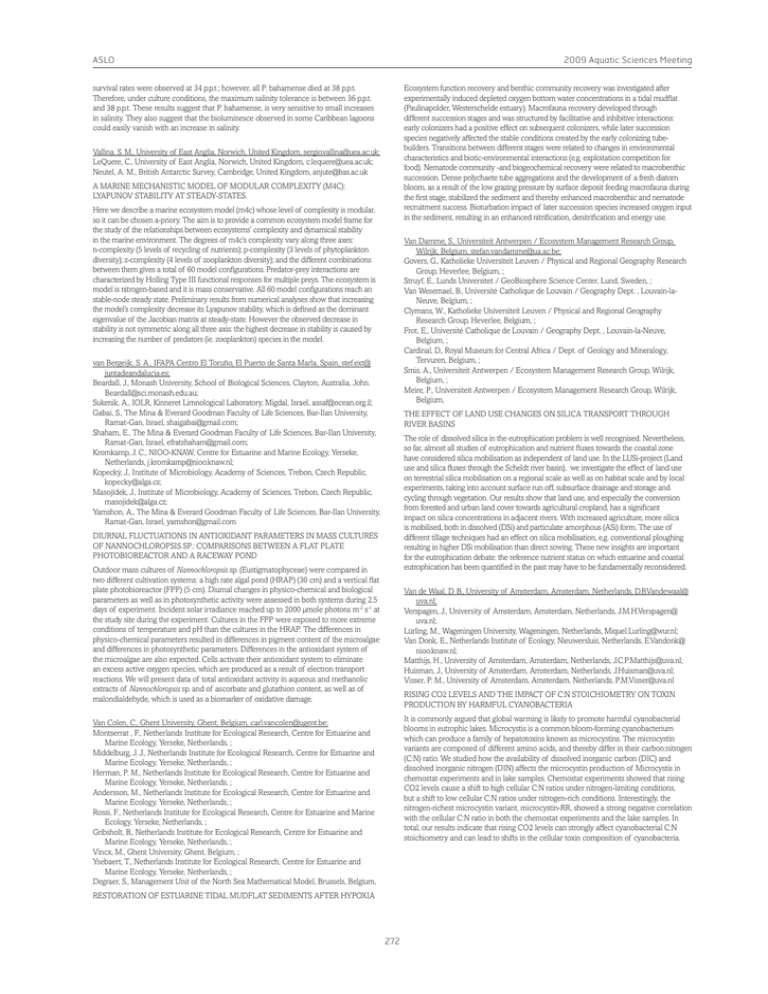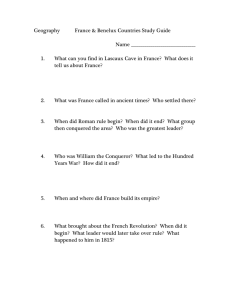ASLO 2009 Aquatic Sciences Meeting
advertisement

ASLO 2009 Aquatic Sciences Meeting survival rates were observed at 34 p.p.t.; however, all P. bahamense died at 38 p.p.t. Therefore, under culture conditions, the maximum salinity tolerance is between 36 p.p.t. and 38 p.p.t. These results suggest that P. bahamense, is very sensitive to small increases in salinity. They also suggest that the bioluminesce observed in some Caribbean lagoons could easily vanish with an increase in salinity. Ecosystem function recovery and benthic community recovery was investigated after experimentally induced depleted oxygen bottom water concentrations in a tidal mudflat (Paulinapolder, Westerschelde estuary). Macrofauna recovery developed through different succession stages and was structured by facilitative and inhibitive interactions: early colonizers had a positive effect on subsequent colonizers, while later succession species negatively affected the stable conditions created by the early colonizing tubebuilders. Transitions between different stages were related to changes in environmental characteristics and biotic-environmental interactions (e.g. exploitation competition for food). Nematode community -and biogeochemical recovery were related to macrobenthic succession. Dense polychaete tube aggregations and the development of a fresh diatom bloom, as a result of the low grazing pressure by surface deposit feeding macrofauna during the first stage, stabilized the sediment and thereby enhanced macrobenthic and nematode recruitment success. Bioturbation impact of later succession species increased oxygen input in the sediment, resulting in an enhanced nitrification, denitrification and energy use. Vallina, S. M., University of East Anglia, Norwich, United Kingdom, sergio.vallina@uea.ac.uk; LeQuere, C., University of East Anglia, Norwich, United Kingdom, c.lequere@uea.ac.uk; Neutel, A. M., British Antarctic Survey, Cambridge, United Kingdom, anjute@bas.ac.uk A MARINE MECHANISTIC MODEL OF MODULAR COMPLEXITY (M4C): LYAPUNOV STABILITY AT STEADY-STATES. Here we describe a marine ecosystem model (m4c) whose level of complexity is modular, so it can be chosen a-priory. The aim is to provide a common ecosystem model frame for the study of the relationships between ecosystems’ complexity and dynamical stability in the marine environment. The degrees of m4c’s complexity vary along three axes: n-complexity (5 levels of recycling of nutrients); p-complexity (3 levels of phytoplankton diversity); z-complexity (4 levels of zooplankton diversity); and the different combinations between them gives a total of 60 model configurations. Predator-prey interactions are characterized by Holling Type III functional responses for multiple preys. The ecosystem is model is nitrogen-based and it is mass conservative. All 60 model configurations reach an stable-node steady state. Preliminary results from numerical analyses show that increasing the model’s complexity decrease its Lyapunov stability, which is defined as the dominant eigenvalue of the Jacobian matrix at steady-state. However the observed decrease in stability is not symmetric along all three axis: the highest decrease in stability is caused by increasing the number of predators (ie. zooplankton) species in the model. Van Damme, S., Universiteit Antwerpen / Ecosystem Management Research Group, Wilrijk, Belgium, stefan.vandamme@ua.ac.be; Govers, G., Katholieke Universiteit Leuven / Physical and Regional Geography Research Group, Heverlee, Belgium, ; Struyf, E., Lunds Universitet / GeoBiosphere Science Center, Lund, Sweden, ; Van Wesemael, B., Université Catholique de Louvain / Geography Dept. , Louvain-laNeuve, Belgium, ; Clymans, W., Katholieke Universiteit Leuven / Physical and Regional Geography Research Group, Heverlee, Belgium, ; Frot, E., Université Catholique de Louvain / Geography Dept. , Louvain-la-Neuve, Belgium, ; Cardinal, D., Royal Museum for Central Africa / Dept. of Geology and Mineralogy, Tervuren, Belgium, ; Smis, A., Universiteit Antwerpen / Ecosystem Management Research Group, Wilrijk, Belgium, ; Meire, P., Universiteit Antwerpen / Ecosystem Management Research Group, Wilrijk, Belgium, van Bergeijk, S. A., IFAPA Centro El Toruño, El Puerto de Santa Marla, Spain, stef.ext@ juntadeandalucia.es; Beardall, J., Monash University, School of Biological Sciences, Clayton, Australia, John. Beardall@sci.monash.edu.au; Sukenik, A., IOLR, Kinneret Limnological Laboratory, Migdal, Israel, assaf@ocean.org.il; Gabai, S., The Mina & Everard Goodman Faculty of Life Sciences, Bar-Ilan University, Ramat-Gan, Israel, shaigabai@gmail.com; Shaham, E., The Mina & Everard Goodman Faculty of Life Sciences, Bar-Ilan University, Ramat-Gan, Israel, efratshaham@gmail.com; Kromkamp, J. C., NIOO-KNAW, Centre for Estuarine and Marine Ecology, Yerseke, Netherlands, j.kromkamp@nioo.knaw.nl; Kopecký, J., Institute of Microbiology, Academy of Sciences, Trebon, Czech Republic, kopecky@alga.cz; Masojídek, J., Institute of Microbiology, Academy of Sciences, Trebon, Czech Republic, masojidek@alga.cz; Yamshon, A., The Mina & Everard Goodman Faculty of Life Sciences, Bar-Ilan University, Ramat-Gan, Israel, yamshon@gmail.com THE EFFECT OF LAND USE CHANGES ON SILICA TRANSPORT THROUGH RIVER BASINS The role of dissolved silica in the eutrophication problem is well recognised. Nevertheless, so far, almost all studies of eutrophication and nutrient fluxes towards the coastal zone have considered silica mobilisation as independent of land use. In the LUSi-project (Land use and silica fluxes through the Scheldt river basin), we investigate the effect of land use on terrestrial silica mobilisation on a regional scale as well as on habitat scale and by local experiments, taking into account surface run off, subsurface drainage and storage and cycling through vegetation. Our results show that land use, and especially the conversion from forested and urban land cover towards agricultural cropland, has a significant impact on silica concentrations in adjacent rivers. With increased agriculture, more silica is mobilised, both in dissolved (DSi) and particulate amorphous (ASi) form. The use of different tillage techniques had an effect on silica mobilisation, e.g. conventional ploughing resulting in higher DSi mobilisation than direct sowing. These new insights are important for the eutrophication debate: the reference nutrient status on which estuarine and coastal eutrophication has been quantified in the past may have to be fundamentally reconsidered. DIURNAL FLUCTUATIONS IN ANTIOXIDANT PARAMETERS IN MASS CULTURES OF NANNOCHLOROPSIS SP.: COMPARISONS BETWEEN A FLAT PLATE PHOTOBIOREACTOR AND A RACEWAY POND Outdoor mass cultures of Nannochloropsis sp. (Eustigmatophyceae) were compared in two different cultivation systems: a high rate algal pond (HRAP) (30 cm) and a vertical flat plate photobioreactor (FPP) (5 cm). Diurnal changes in physico-chemical and biological parameters as well as in photosynthetic activity were assessed in both systems during 2.5 days of experiment. Incident solar irradiance reached up to 2000 µmole photons m-2 s-1 at the study site during the experiment. Cultures in the FPP were exposed to more extreme conditions of temperature and pH than the cultures in the HRAP. The differences in physico-chemical parameters resulted in differences in pigment content of the microalgae and differences in photosynthetic parameters. Differences in the antioxidant system of the microalgae are also expected. Cells activate their antioxidant system to eliminate an excess active oxygen species, which are produced as a result of electron transport reactions. We will present data of total antioxidant activity in aqueous and methanolic extracts of Nannochloropsis sp. and of ascorbate and glutathion content, as well as of malondialdehyde, which is used as a biomarker of oxidative damage. Van de Waal, D. B., University of Amsterdam, Amsterdam, Netherlands, D.B.Vandewaal@ uva.nl; Verspagen, J., University of Amsterdam, Amsterdam, Netherlands, J.M.H.Verspagen@ uva.nl; Lürling, M., Wageningen University, Wageningen, Netherlands, Miquel.Lurling@wur.nl; Van Donk, E., Netherlands Institute of Ecology, Nieuwersluis, Netherlands, E.Vandonk@ nioo.knaw.nl; Matthijs, H., University of Amsterdam, Amsterdam, Netherlands, J.C.P.Matthijs@uva.nl; Huisman, J., University of Amsterdam, Amsterdam, Netherlands, J.Huisman@uva.nl; Visser, P. M., University of Amsterdam, Amsterdam, Netherlands, P.M.Visser@uva.nl RISING CO2 LEVELS AND THE IMPACT OF C:N STOICHIOMETRY ON TOXIN PRODUCTION BY HARMFUL CYANOBACTERIA It is commonly argued that global warming is likely to promote harmful cyanobacterial blooms in eutrophic lakes. Microcystis is a common bloom-forming cyanobacterium which can produce a family of hepatotoxins known as microcystins. The microcystin variants are composed of different amino acids, and thereby differ in their carbon:nitrogen (C:N) ratio. We studied how the availability of dissolved inorganic carbon (DIC) and dissolved inorganic nitrogen (DIN) affects the microcystin production of Microcystis in chemostat experiments and in lake samples. Chemostat experiments showed that rising CO2 levels cause a shift to high cellular C:N ratios under nitrogen-limiting conditions, but a shift to low cellular C:N ratios under nitrogen-rich conditions. Interestingly, the nitrogen-richest microcystin variant, microcystin-RR, showed a strong negative correlation with the cellular C:N ratio in both the chemostat experiments and the lake samples. In total, our results indicate that rising CO2 levels can strongly affect cyanobacterial C:N stoichiometry and can lead to shifts in the cellular toxin composition of cyanobacteria. Van Colen, C., Ghent University, Ghent, Belgium, carl.vancolen@ugent.be; Montserrat , F., Netherlands Institute for Ecological Research, Centre for Estuarine and Marine Ecology, Yerseke, Netherlands, ; Middelburg, J. J., Netherlands Institute for Ecological Research, Centre for Estuarine and Marine Ecology, Yerseke, Netherlands, ; Herman, P. M., Netherlands Institute for Ecological Research, Centre for Estuarine and Marine Ecology, Yerseke, Netherlands, ; Andersson, M., Netherlands Institute for Ecological Research, Centre for Estuarine and Marine Ecology, Yerseke, Netherlands, ; Rossi, F., Netherlands Institute for Ecological Research, Centre for Estuarine and Marine Ecology, Yerseke, Netherlands, ; Gribsholt, B., Netherlands Institute for Ecological Research, Centre for Estuarine and Marine Ecology, Yerseke, Netherlands, ; Vincx, M., Ghent University, Ghent, Belgium, ; Ysebaert, T., Netherlands Institute for Ecological Research, Centre for Estuarine and Marine Ecology, Yerseke, Netherlands, ; Degraer, S., Management Unit of the North Sea Mathematical Model, Brussels, Belgium, RESTORATION OF ESTUARINE TIDAL MUDFLAT SEDIMENTS AFTER HYPOXIA 272





